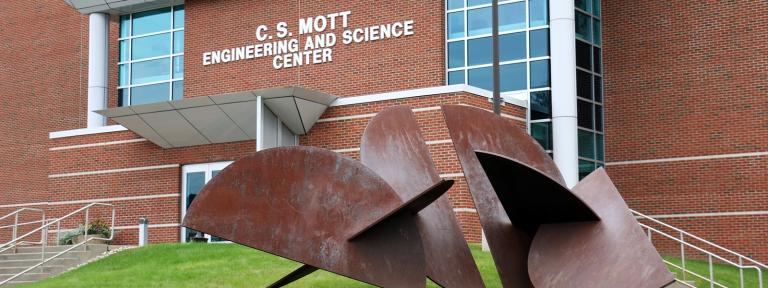
“In our work, we simulated the entire flat plate reformer’s electro-kinetics and carried out parametric studies that provide guidance for the practical implementation of such design.”
The Kettering Center for Fuel Cell Systems and Powertrain Integration has been researching renewable fuels and energy for the 21st Century. Dr. Susanta Kumar Das, assistant professor of Mechanical Engineering, and Dr. K. Joel Berry, professor of Mechanical Engineering, have completed multiple research projects including: “Experimental performance evaluation of a 1kW high temperature PEM fuel cell stack prototype,” by Susanta K. Das, Antonio Reis and K. J. Berry, and “Performance evaluation of a catalytic flat plate fuel reformer for on-board hydrogen generation,” by Susanta K. Das, Kranthi K. Gadde and K. J. Berry.
In the “Experimental Performance Evaluation of a 1kW High Temperature PEM Fuel Cell Stack Prototype” project the researchers experimentally studied performance of the newly designed 1 kW high temperature PEM fuel cell stack prototype at different operating conditions for possible commercialization purposes.
“Enhanced electrochemical kinetics, useful waste heat recovery, and utilization of higher CO-rich reformate makes high temperature proton exchange membrane (PEM) fuel cell a viable candidate for useful commercial applications such as auxiliary power unit (APU),” said Das.
“Both from the technological point of view and the use of existing refueling infrastructure, it is preferable to use hydrogen-rich reformate in PEM fuel cell stack,” he added.
With their research, the performance of the fuel cell stack in terms of current-voltage characteristics was experimentally measured for each of the cells in the 1kW stack. Experimental data of this type is required to develop and validate the fuel cell models to understand and optimize the operation of the stack and further improvement of stack design.
The quantitative experimental results showed variations in current-voltage characteristics at different temperatures with fixed anode and cathode stoichiometry. “The results were very helpful to understanding each cell performance in the stack in terms of current-voltage characteristics, while fed with reformate with different CO concentrations in the anode fuel stream,” said Das.
The “Performance Evaluation of a Catalytic Flat Plate Fuel Reformer For On-Board Hydrogen Generation” project in collaboration with Kranthi K. Gadde, a graduate student in Mechanical Engineering at Kettering, was a two-dimensional computational fluid dynamics (CFD) model of a catalytic flat plate steam reformer with co-current flow arrangement.
The two-dimensional approach makes the model more realistic, according to Das, by increasing its capability to capture the effect of design parameters such as catalyst thickness, reaction rates, inlet temperature and velocity, and channel height, and eliminates the uncertainties introduced by heat and mass transfer coefficients used in one-dimensional models.
“In our work, we simulated the entire flat plate reformer’s electro-kinetics and carried out parametric studies that provide guidance for the practical implementation of such design,” Das said. “The operating conditions are chosen carefully so that it makes possible a good comparison of performance between the catalytic flat plate reformer and the conventional steam reformer,” he added.
The trio designed a catalytic flat plate fuel reformer prototype based on the CFD simulation results and the performance of the reformer prototype is evaluated using bio-fuel. The effect of reformate gas on the current-voltage characteristics of a high temperature PEM fuel cell (HTPEMFC)1 stack was investigated extensively.
“The results are promising for understanding the overall system performance development strategy of HTPEMFC stack in terms of current-voltage characteristics while fed with reformate directly from the flat plate reformer,” said Das.
Additionally, a $1.25 million DOE-funded project “21st Century Renewable Fuels, Energy, and Materials Initiative,” partnered Das and Berry with Michigan Molecular Institute and Saginaw Valley State University. The research stems from Department of Energy (DOE)-funded projects at the Kettering Center for Fuel Cell System and Powertrain Integration related to the development of Fuel Cell Systems and Sustainable Renewable Energy technology.
Components of the project included development of an improved high-temperature fuel cell membrane, development of a 5k novel catalytic flat plate steam reforming process for extracting hydrogen from multi-fuels and integrating it with high-temperature fuel cell systems.
Other components of the project were development of an improved oxygen permeable membrane for high power density lithium-air batteries with simple control systems and reduced cost, development of novel high energy yield agriculture bio-crop (Miscanthus) for alternative fuels with minimum impact on human food chain and finally, development of a course module to extend a math and science alternative energy educator program to include bio-energy and power.
Das presented their research in two lectures at the 19th World Hydrogen Energy Conference 2012 in June in Toronto and also presented their updated research results during the DOE annual merit review 2012 meeting held in May at Washington D.C. Additional research results will be presented at the ASME International Hydrogen Fuel Cell Science and Technology Conference to be held in July 2013 in San Diego, California.